“Fight just like a Polish soldier has always done throughout history. Fight tenaciously, and yet chivalrously!” Thus, General Stanisław Maczek, the model of an indomitable soldier, encouraged his soldiers to fight. Jacques Wiacek, author of “Histoire de la 1re division blindée polonaise (1939-1945): L’odyssée du phénix”, first French-language monograph on the 1st Division of General Maczek, discusses General’s role in the battles of the Second World War and the way he is remembered today.
polishhistory: You titled your book about General Maczek and his division “The Phoenix Odyssey.” Why choose “odyssey”?
Jacques Wiacek: Just as the mythical Odysseus left his Penelope and went to Troy, General Maczek left his homeland in 1939 and entered combat. His odyssey led him through several countries. After the Red Army entered Poland, he managed to get to Hungary, from where he went to France to fight with Polish soldiers in the battle for France. After the fall of France, he reached Great Britain, where he was entrusted with the command of the newly created 1st Division. He led it through battles in several countries – France, Belgium, the Netherlands and Germany. During these fights, Polish soldiers successfully fought off German attacks, and liberated many towns – they fought on many fronts and in many important battles in Europe.
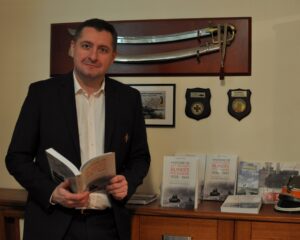
And where did the Phoenix come from?
The mythological Phoenix had the ability to be reborn from the ashes, to rise again. It was similar with Maczek’s soldiers – formed successively in the 10th Cavalry Brigade, the 10th Armored Cavalry Brigade and finally in the 1st Armored Division. It can be said that they, too, were able to “revive,” and to recover from almost every defeat. The battle for Poland was lost in 1939, and a few months later the battle for France, too. Nevertheless, the formation as such retained its character and continued fighting. Maczek’s soldiers were able to successfully break through the enemy lines and fight off, and often displace, German forces. This rebirth and growing in strength despite defeat made a great impression on me – hence the choice of such a title.
The history of Maczek’s soldiers, but also the history of the Second World War, begins in Poland, in September 1939. How are the battles in September perceived in the West today?
This topic is still relatively unknown. For the French, the war began in 1940 with the battle for France, and many people are convinced that the Second World War lasted from 1940 till 1945, if not till 1944. The outbreak of the war in Poland in September 1939 is sometimes omitted and marginalized. This is perhaps because many people in the West do not know the economic, political or international background of this conflict. Hence, the image of the September outbreak of the war is often simplified, people refer to caricatures or irony. Most often it is motivated by the desire to hide the fact that neither England nor France fulfilled their alliance obligations and did not help Poland in the face of German aggression.
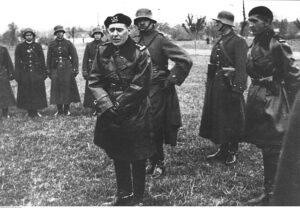
However, when the topic is properly delineated, then interest in the September fights grows. I was once asked to write an article about the TKS – Polish tankettes (small combat vehicles), which were one of the basic weapons of the Polish armored forces during September 1939. It is quite a specialized topic, and it might seem of interest only to experts or enthusiasts – yet interest in it was high.
How were Maczek’s soldiers treated in the countries where they were stationed – in France and Great Britain?
During the battle for France in 1940, the 10th Armored Cavalry Brigade – the unit created as a result of the reconstruction of the 10th Cavalry Brigade which was disarmed after the defeat of September 1939 – was only in the organizational phase. The French army was not well prepared for the conflict, and had huge shortages in equipment and weapons. Therefore, the French were reluctant to acknowledge the necessity to arm Polish soldiers. Hence, Polish officers managed to obtain only small amounts of training equipment. The situation began to change only after Germany invaded France. It was then that Maczek received an order defining the form of the Polish unit, and his soldiers were supplied with the necessary equipment. Then, within a few days, they were included in the French 4th Army and sent into combat.
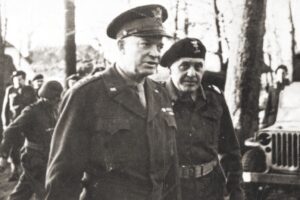
The situation in Great Britain was much different. It was rather peaceful there, and both the organization and attitude towards Polish soldiers were better – which was probably also due to the fact that the country did not feel a direct threat from Germany. Relations with civilians were also very good, as evidenced by a fairly large number of Polish-Scottish marriages concluded during those four years, when Maczek’s soldiers stayed in the vicinity of Edinburgh.
During the fights, Maczek’s soldiers liberated at least a few towns – and the liberation of Breda became a symbol. How were they received in these cities? How were they welcomed by the local people?
They were met with great enthusiasm from the local population, with the exception of Germany. The local propaganda presented the Allies in the worst light, proclaiming that Maczek’s soldiers were brutally taking revenge on Germans for starting the war, murdering civilians and wreaking havoc. This was, of course, not true. General Maczek called his soldiers to fight “tenaciously, and yet chivalrously”, and the proof of faithfulness to this principle was, for example, the liberation of Breda. It was carried out without the use of artillery in order to spare the civilian population. The intimidated German population, however, believed in the narrative created by the propaganda. As a result, members of the Division recalled years later that they had passed through empty villages in Germany – the local population hid in forests or bunkers, intimidated by the “black” brigade.
This image contrasted sharply with the warm and enthusiastic reception of Poles by the Belgian or Dutch population. The above-mentioned Breda became a symbol. After the liberation of this town, enthusiastic residents appeared on the streets, cheering and showering Maczek’s soldiers with flowers, while shop windows were covered with posters saying in Polish “Thank you, Poles,” The enthusiasm was tremendous. The same was true in Belgium and northern France. In Normandy and on the Belgian-Dutch border, the Division was welcomed slightly less warmly, this, however, resulted from the extent of the fights in this area. They had ended in mass destruction, as a result of which people lost their homes and properties. Thus, the moods were less enthusiastic, but the great effort and heroism of Maczek’s soldiers were still appreciated.
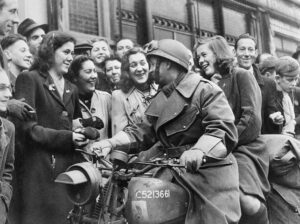
In 1944-1945, the 1st Armored Division of General Maczek fought in France, Belgium, the Netherlands and Germany, participating in important battles and the liberation of several towns. Which event from this period in the history of Maczek’s soldiers is, in your opinion, the most interesting and deserves the greatest attention?
It depends from what perspective you look at it. For me, at least three events deserve special recognition. From a military point of view, the battle of Falaise was the most significant, from 7 to 21 August 1944 – it was very bloody, but also extremely important. Thanks to it, the German defense was broken in Normandy, enabling the Allies to reach the line of the Seine. Of all the fights that Maczek’s soldiers fought, this one was undoubtedly of the greatest military importance. The liberation of Breda was another very interesting event. The liberation of this city, an important transport hub, was one of the most spectacular acts of the 1st Armored Division. Many soldiers, forced to remain in exile, returned there after the war, and General Maczek himself was buried there – together with his soldiers.
The third, equally symbolic event was the liberation of the Oberlangen POW camp, in which there were over 1,700 former members of the Home Army, participants of the Warsaw Uprising. It was extremely touching – not only for those women liberated by their countrymen, but also for Maczek’s soldiers. Many of them had fought for the freedom of other nations for six years and had liberated foreign cities. Freeing the Polish women made their struggles meaningful and confirmed that their struggle had not been in vain.
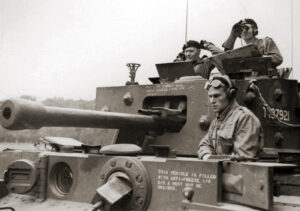
After the liberation of the camp, the 1st Armoured Division continued to fight in Germany until 5 May 1945, i.e. until the capture of the German naval base, Wilhelmshaven. How was this base seized?
Maczek’s army crossed the German border in April 1945. After the liberation of Oberlangen, they were directed to the north-east of the country, with the task of conquering Wilhelmshaven, where the Kriegsmarine base was located, one of the most modern bases of the German fleet. The fighting lasted until 5 May – then the fortress surrendered to Colonel Antoni Grudziński, and Maczek himself coordinated the Division. What is interesting – General Guy Simonds, commander of the 2nd Canadian Corps under which the 1st Division was directly subordinated, agreed that the Poles should take Wilhelmshaven. Even though the Canadians also wanted to capture this base, the task was left to the tankmen – perhaps in the form of a symbolic thank you for their heroic fight.
It is estimated that during the fights of the 1st Division in Western Europe, over 52,000 Wehrmacht soldiers were taken prisoner by Poland. Why was the Polish Division so effective?
First of all, there was no doubt about General Maczek’s leadership commanding skills. He already had experience in battle. He did not take command of the armored forces by accident – as early as 1918 he had fought at the head of fast, maneuverable units when he commanded an assault battalion. It is important that during the fighting on the fronts of Western Europe through which Polish soldiers passed, they remained together, and did not separate. The equipment that they had at their disposal also played a significant role. I must admit that it was a good weapon – maybe not like the German one, but it allowed them to keep up their readiness for battle. If, however, I were to point out the most important thing, it would undoubtedly be Maczek’s skills. He was able not only to effectively command the soldiers in terms of tactics, but also to convey to them the will and meaning of the fight.
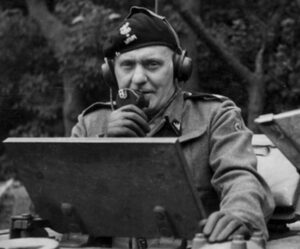
General Maczek became a hero of several nations. How is he perceived in the West today?
The memory of General Maczek and the 1st Armored Division is alive, and they are especially present in the cities they liberated. In France, Belgium and the Netherlands, ceremonies commemorating the liberation have been organized for many years. In the Netherlands, the profile of the ceremonies are high level, not only featuring the city authorities but also its inhabitants. They remember to whom they owe their freedom. It is similar in France. Although these celebrations may not take place on such a large scale, in recent years they have been gaining more and more interest not only by the Polish diaspora, but also among the French, including increasingly younger generations. For me – a Pole living in France – it is extremely encouraging.
“A Polish soldier fights for the freedom of all nations, but he dies only for Poland” – this is the inscription engraved on the plinth of the monument to General Maczek in Warsaw. What role does Stanisław Maczek play in Polish history? What can he teach us today?
The figure of General Maczek has grown today to the rank of a symbol, which is perfectly justified – it is one of the few success stories of our army in this period. For Poland, the Second World War was a period of real danger, not only to the nation, but also to its biological substance. The epic of Maczek and his soldiers gives some sense to these sufferings, proves that they were not in vain, and that it was worth fighting for freedom – even if Poland had to wait a bit longer for theirs.
Although the heroic fight of the soldiers of the 1st Division did not bring Poland the desired freedom, and Maczek himself was never given the chance to return to his homeland, he was able to maintain internal freedom. He never succumbed to the pressure, and he kept fighting to the end, even when the situation seemed to be lost. He set such an example to his soldiers, that it remains valid both today and for subsequent generations.
Interviewer: Natalia Pochroń
Translation: Alicja Rose & Jessica Sirotin





